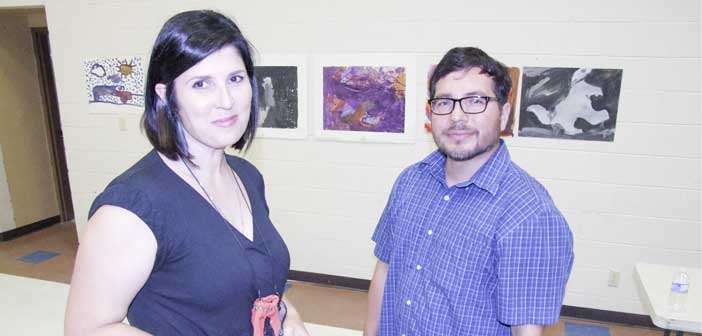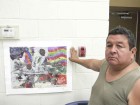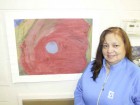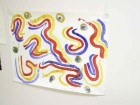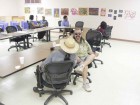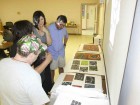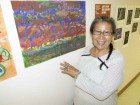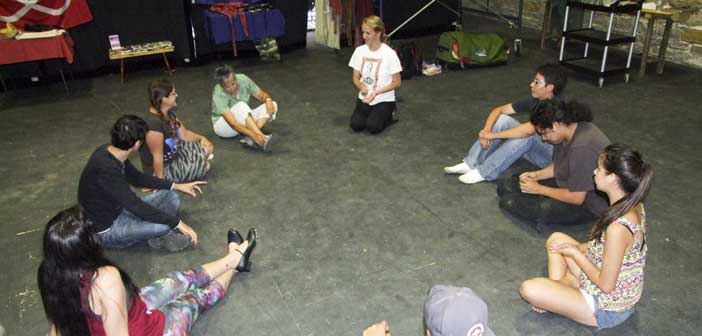MANITOULIN—Most people have heard the Hans Christian Andersen fable ‘The Emperor’s New Clothe s’ wherein a young child unmasks a con artist’s ploy to convince a hubris laden emperor that the new clothes they had sold him were made with magical cloth, but a trio of scientists are taking advantage of a serendipitous discovery of a large cache of children’s art and the unfettered honesty of a child’s vision to study First Nations’ society in the seminal period of the late 1960s and early 1970s.
Darrel Manitowabi, PhD program coordinator at ’s School of Northern Development Anthropology Program, is collaborating with Dr. Andrea Walsh, a visual anthropologist at the University of Victoria, and Laurentian University research assistant Mary Pheasant “on research pertaining to the Robert Aller art collection.”
Dr. Manitowabi explains that Robert Aller was an artist and art teacher who passed away in 2008. “Upon his death, Mr. Aller’s art collection (personal works and acquired pieces from his students) was donated to the University of Victoria,” he said.
What makes Mr. Aller’s collection so exciting was the serendipitous discovery of a cache of children’s art from across Canada (and particularly Manitoulin).
After initially volunteering to teach children art at the Fort Alberni residential school, Dr. Aller was contracted by Indian Affairs in 1968 to run summer art camps for children on Manitoulin Island.
“He held camps at Whitefish River, M’Chigeeng (then known as West Bay) and Wikwemikong during the period between June 17-August 2, 1968,” said Dr. Manitowabi. “These art camps took place in public settings over a number of days and were held all day. At the conclusion of the camp, Dr. Aller hosted a community art show, profiling the art created by the children, who ranged in age from 6-12. At each camp, Dr. Aller collected some art samples from the students and in total 175 pieces of art were collected from Manitoulin.”
That artwork was carefully packed away, wrapped securely in plastic garbage bags and stored at Dr. Aller’s home. The magic in its discovery was that one of Dr. Aller’s Fort Alberni students was the University of Victoria official sent to pick up the artist’s collection.
“The family said to him, ‘we have these other things that we don’t know what to do with’,” said Dr. Walsh during a presentation held recently at the Whitefish River Community Centre. “As soon as he opened the first bag, he knew immediately what he was looking at.”
Dr. Walsh, who is a member of the Salish people of British Columbia, has an artistic background herself, having started out studying graphic arts before being attracted to the study of anthropology.
She explained that Dr. Aller’s teaching approach was considered very unusual at the time of the art camps. “He was appalled at what he saw happening at the residential school at the time, in many ways was he was a revolutionary,” she said. “He did not tell the children what to draw, he simply taught them the materials and skills to create their artworks, they chose the subject matter.”
Each child would produce three or four paintings a day during the camps and the result was the creation of literally thousands of pieces of art. “At the end of each art camp, Dr. Aller would hold an art show with the children,” said Dr. Walsh. “He would ask the children if he could take some of their work with him.” The result was a unique collection of what is essentially ‘fridge art’ created by children, some of whom would go on to become significant artists in their own right.
“A significant part of our research is to return to each of these communities with the original art pieces to stage an art show for community members, profiling these pieces,” said Dr. Manitowabi. “Our intention is to have these works of art returned to the artists, or have them loan the art to Laurentian University for future art shows or research.”
Connecting with the former students is a monumental task, with several complicating factors—who among us remembers the art they created 40 or 50 years ago as young children.
For Ms. Pheasant herself, the project came with a personal shock. “I found one with my name on it,” she laughed. “I don’t even remember painting it.”
But she did, on reflection, remember Dr. Aller. “He was a friend of my parents,” she said. Her brother, Roland Jacko, also recalled Dr. Aller. Mr. Jacko painted his portrait as a young man, so they spent many days together.
“He was a very nice man,” said Mr. Jacko. He noted that the artists always treated him with respect and consideration, something that wasn’t very common for children in late 1960s when children were often expected to be “seen and not heard” when in adult company.
Ms. Pheasant had recently taken up painting again and the painting from her past contained significant revelation. “It is very much like the artwork I do now,” she said. Looking at the painting one discovers seven orbs and the traditional colours of the medicine wheel. Although she describes her family as very traditional, she said that the similarity of the subject matter is far more than coincidental. “It goes to show that our culture is not something merely learned and passed on,” she said. “It is something that resides deep within our genes.”
The researchers hope that they will be able to connect with many of the original artists and they held a series of displays in the communities where the artwork was originally created to that end. Publishing the names of the artists had problematic issues, noted Ms. Walsh, and in order to protect the privacy of the artists, a special one-hour viewing took place prior to the public seminar and show.
“We have seen some very emotional responses,” she said.
In one example, Olga Cywink not only discovered her own artwork amongst the pieces on display at Whitefish River, she also found the works of two of her other sisters, one of whom, Sonia, was murdered more than 20 years ago.
Louis Debassige of M’Chigeeng, a retired educator and administrative official, attended the session at the Ojibwe Cultural Foundation and proved to be an incredible font of information for the researchers in tracking down many of the artists. But there were plenty of tragic moments in Mr. Debassige’s litany of names. “He died on the streets of Winnipeg,” he said of one of the artists, but there were also many more positive stories to be told. “He is an entrepreneur up North, she is a housewife who raised a family here, he has a successful business in southern Ontario.”
Muriel Wakegijig (nee Assinewai) was 12 when she created her artwork, but she too admits not recalling creating the work. “No, I don’t remember, but I was pretty good,” she laughed. Ms. Wakegijig said that it was very interesting to see the artwork from so long ago and said that she knew most of the people whose art was on display.
The researchers are hoping to have more opportunities to display the work in the future. Dr. Walsh can be contacted at the Department of Anthropology of the University of Victoria and Dr. Manitowabi or Ms. Pheasant can be contacted at Laurentian University at 705-675-1151, extension 5063.

